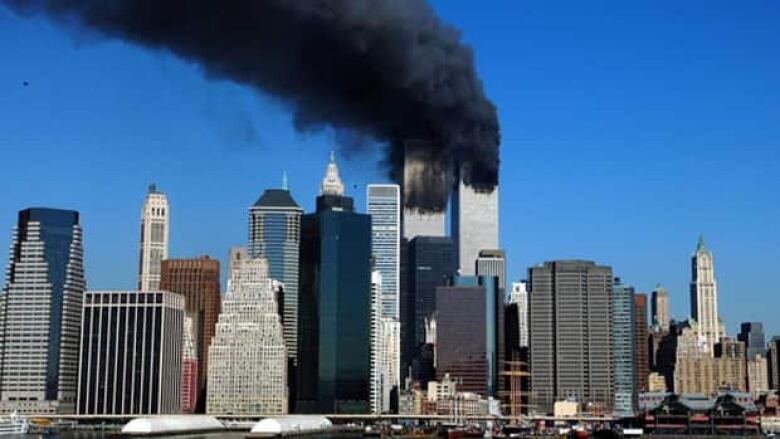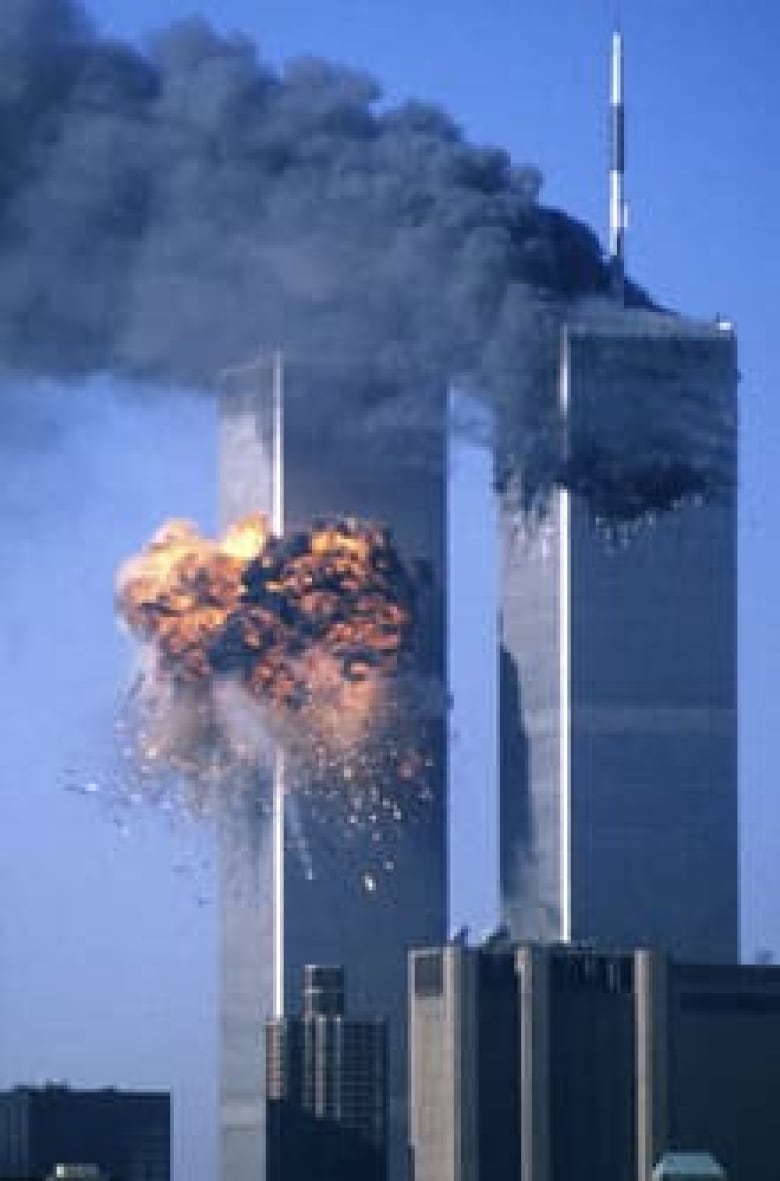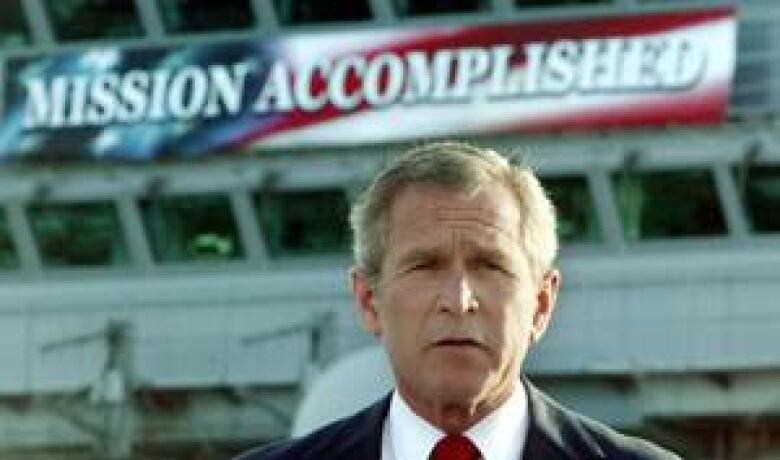9/11: A day of infamy

On the morning of Sept. 11, 2001, four U.S. airliners were turned into guided missiles after they were hijacked by al-Qaeda suicide bombers and crashed into three sites in the U.S., killing approximately 3,000 people.
Two of the planes struck the twin towers of the World Trade Center in New York, igniting fires that destroyed the 110-storey landmarks while a third crashed into the west wing of the Pentagon in Washington. A fourth plane, which was believed to be heading for the White House, crashed in a field 120 kilometres southeast of Pittsburgh.
U.S. targets Al-Qaeda
Not long after Sept. 11, U.S. officials accused Kuwait-born Khalid Sheik Mohammed of being the senior al-Qaeda strategist who orchestrated the attacks.Mohammed had been previously implicated in a 1995 plot known as Operation Bojinka, anearly attempt at a Sept. 11-styleassault. The plot was uncovered by police in the Philippines before it could be carried out.

Mohammed was captured in Pakistan in 2003, held inC.I.A.-run secret prisons until 2006 and then transferred to the U.S. military prison in Guantanamo Bay, Cuba, set up in the wake of in 9/11. It wasat hearings there that he reportedly admitted to planning the 9/11 attacks and several other plots although a U.S. Justice Department memo released latershowed that he had been subject to waterboarding and other harsh interrogation methods while in custody.Heis set to be tried by a military commission at Guantanamo along with four other men charged in connection with the 9/11 attacks: Walid bin Attash, Ramzi bin Al-Shibh, Ali Abdul Aziz Ali, and Mustafa Al-Hawsawi.
The first person to be charged in connection with the Sept. 11 attacks wasZacarias Moussaoui, widely believed to have been intended to be the 20th hijacker. He was arrested on immigration violations in August 2001 prior to the attacks after arousing suspicion at a Minnesota flight school, charged in December 2001 with several counts of conspiracy and sentenced to life in prison in 2006.
Into Afghanistan
Less than a month after the Sept. 11 attacks onOct. 7, 2001 the U.S. launched air strikes against Afghanistan, targeting al-Qaeda training camps and the country's ruling Taliban government, which had been providing a safe haven foral-Qaedaand its leader, Osama bin Laden,since 1996. The strikes were the beginning of what became a protracted war against the Taliban and al-Qaeda. What started out as a U.S.-led operation in 2001 eventually turned into one overseen by NATO that involved several Western countries, including Canada,and continues to this day.
Bin Laden, who founded al-Qaeda in 1989 and whose wealth and preachings are believed to have funded andinspired numerous attacks against the U.S. on home andforeign soil in the years leading up to 9/11,was quick to respond to the U.S. invasion of Afghanistan, releasing a videotaped message a few hours after the start of air strikes praising those who carried outthe 9/11 attacks and calling for "all the infidel armies leave the land of Muhammad."
Bin Laden became the target of a massive manhunt that lasted 10 years. On May 1, 2011, U.S. President Barack Obama announced that bin Laden had been killed in Pakistan in acovert operation led by CIA paramilitaries andU.S. Navy SEALs. After years of eluding capture, bin Laden was found in a heavily fortified residence in Abbottabad, about 150 kilometres north of Islamabad. According to media reports, his capture was the result of a lengthy intelligence operation and leads obtained through interrogation of prisoners in secret overseas prisons.
Rude awakening
The 9/11 attacks forced a new reality on the Western world and on Americans in particular.
Soon after the event, evidence emerged thatU.S. authorities had received warnings about imminent attacks in the months leading up to Sept. 11, both from their own intelligence agencies and at least four foreign governments.
Much of that evidence came out of the investigation into the attacks launched by the National Commission on Terrorist Attacks Upon the United States, known as the 9/11 Commission, which was created in late 2002 and released itsfinal report in July 2004.
The commission concluded that the U.S. record on tracking and preventing the activities of al-Qaeda was a series of intelligence and communication failures and missed opportunities. "None of the measures adopted by the U.S. government from 1998 to 2001 disturbed or even delayed the progress of the al-Qaeda [9/11] plot," it concluded.
Patriot Act and beyond
Determined not to be caught off guard again, the administration of George W. Bush dramatically reorganized its intelligence operations and expanded law enforcement agencies' power to detain, conductsurveillance of and access private information about U.S.citizens. Many of these expanded powers were contained in the controversialPatriot Act,passed a little more than a month after the attacks.
The administration alsogreatly expanded the president's executive powers; set up a Department of Homeland Security that introduced drastic changes to rules governing travel in the U.S.and airport and border security; launched a wide-ranging "war on terror," beginning with Afghan invasion; and created special military tribunals to try those it deemed to be "enemy combatants" in that broadly defined war.
In January 2002, the U.S. openedwhat would becomea hugely controversial military prison in Guantanamo Bay, Cuba, and began transporting prisoners there from Afghanistan.The prison, where inmates languished for years without charges,attracted allegations ofcivil rights violations and torture and stood as a symbol of what many saw as the heavy-handed security measures and curtailmentof civil rights that characterized the U.S. response to9/11.

In January 2009, Obama announced he would close the facility, abandon the military tribunalsinstituted after 9/11 and allowterror suspectsto be tried in regular criminalcourts, asjustice advocates had long called for. He has since postponed those changes, leavingthe172 last-remaining prisoners in Guantanamo andallowing military commissions for Mohammed and four other terror suspectsto proceed.
In the spring of 2003, the U.S. went against the recommendations of theUN Security Council andinvaded Iraq as part of its war on terror. It accused Iraqi dictator Saddam Hussein of having weapons of mass destruction and harboring al-Qaeda associates.U.S. forces, with the help ofBritish troops,toppled Saddam, but no weapons of mass destruction were ever found and the intelligence used to justify the invasion has since been shown tohave beenflawed. Aswith Afghanistan, the invasion of Iraq turned into a bloody protracted conflictthat hastriggered fighting among various religious factions within the country and reverberated throughout the Middle East.
U.S. forces began winding down combat operations in Iraq inAugust 2010, seven years after Bushstood before a banner emblazoned with the words "Mission Accomplished" and declared theIraq war over.Obama has vowed tohave all U.S. forces out ofthe country by the end of 2011.
The hijackers
Names used by the hijackers, some of whom learned to fly atU.S. pilot schools:
American Airlines Flight 11 Crashed into New York City's World Trade Center North Tower at 8:48 a.m. ET.
- Mohamed Atta
- Satam al-Suqami
- Waleed M. Alshehri
- Wail M. Alshahri
- Abdulaziz Alomari
United Airlines Flight 175 Crashed into New York City's World Trade Center South Tower at 9:03 a.m. ET.
- Marwan Al-Shehhi
- Ahmed Alghamdi
- Hamza Alghamdi
- Mohald Alshehri
- Fayez Rashid Ahmed Hassan al-Qadi Banihammad
American Airlines Flight 77 Crashed into the Pentagon at 9:39 a.m. ET.
- Khalid Almihdhar
- Majed Moqed
- Nawaf Alhazmi
- Salem Alhamzi
- Hani Hanjour
United Airlines Flight 93 Crashed in a Pennsylvania field at 10:10 a.m. ET.
- Saeed Alghamdi
- Ahmed Alnami
- Ziad Samir al-Jarrah
- Ahmed Ibrahim al-Haznawi












_(720p).jpg)


 OFFICIAL HD MUSIC VIDEO.jpg)
.jpg)



























































































